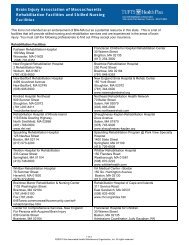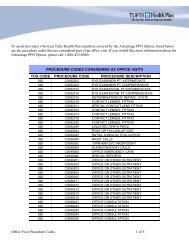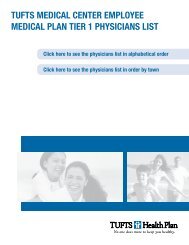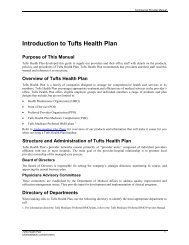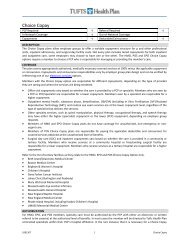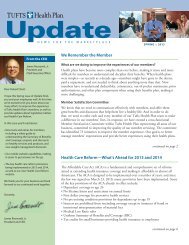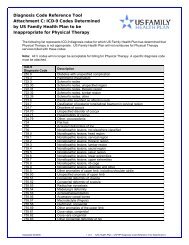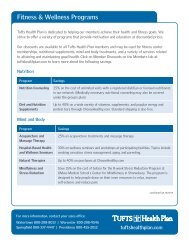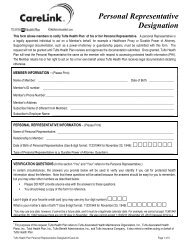Tufts Health Plan SCO Provider Manual - Care Model
Tufts Health Plan SCO Provider Manual - Care Model
Tufts Health Plan SCO Provider Manual - Care Model
- No tags were found...
Create successful ePaper yourself
Turn your PDF publications into a flip-book with our unique Google optimized e-Paper software.
<strong>Tufts</strong> <strong>Health</strong> <strong>Plan</strong>Senior <strong>Care</strong> Options <strong>Provider</strong> <strong>Manual</strong>4 <strong>Care</strong> <strong>Model</strong> for <strong>Tufts</strong> <strong>Health</strong> <strong>Plan</strong> Senior<strong>Care</strong> Options (HMO-SNP)<strong>Tufts</strong> <strong>Health</strong> <strong>Plan</strong> Core PrinciplesThe overarching construct for the <strong>Tufts</strong> <strong>Health</strong> <strong>Plan</strong> Senior <strong>Care</strong> Options (HMO-SNP) is to improveaccess to medical, behavioral health, and social services for all enrolled members. The <strong>Tufts</strong> <strong>Health</strong> <strong>Plan</strong>Senior <strong>Care</strong> Options care model is based on the following core principles and practices, which <strong>Tufts</strong><strong>Health</strong> <strong>Plan</strong> believes form the foundation for measurable cost savings and improved health outcomes forthe dual eligible population:• Affordability - <strong>Tufts</strong> <strong>Health</strong> <strong>Plan</strong> Senior <strong>Care</strong> Options is designed to minimize cost sharing on thepart of the member to improve access to affordable care.• Handle all aspects of the member’s needs holistically: medical, behavioral, social andcommunity - The Senior <strong>Care</strong> Options model of care integrates the member’s Medicaid andMedicare benefits into one benefit package, allowing the Primary <strong>Care</strong> Team (PCT) to coordinatemedical and social/community benefits in an integrated way.• “High-touch” model with a consistent, primary point of contact - The <strong>Tufts</strong> <strong>Health</strong> <strong>Plan</strong> <strong>Model</strong> of<strong>Care</strong> is intended to be a high-touch model that provides frequent contact (via telephone or in person)between plan staff and members to educate members on their condition, address their concerns,proactively monitor health status, and identify health care needs.A <strong>Care</strong> Manager with appropriate language skills will be assigned to each member and will serve asthe primary point of contact. Other members of the care team with specialized skills may need tocontact the member as well; however, they will be introduced through the trusted relationshipbetween the member and the <strong>Care</strong> Manager.• Member engagement and education - The PCT will create an Individualized <strong>Plan</strong> of <strong>Care</strong> (IPC) forall members. The IPC will be actively managed and updated as the member’s situation changes.Members, their families, and caregivers are all critical to the care management process and will beengaged to the greatest extent possible.• Identify high-risk members and provide care coordination and case management services - Allmembers will be evaluated for care coordination needs through initial and ongoing clinicalassessments and other health risk assessment tools. All members will receive some level of carecoordination, and members with more acute and complex needs will be provided more intensive casemanagement through their PCT.• Primary care focused - <strong>Tufts</strong> <strong>Health</strong> <strong>Plan</strong> believes that a well-executed primary care strategy iscritical to the success of managing the dual eligible population. The care management model isstructured to support a partnership between the Primary <strong>Care</strong> <strong>Provider</strong> (PCP) and the member througha supportive “safety net” team approach.• Managing transitions of care – <strong>Tufts</strong> <strong>Health</strong> <strong>Plan</strong> places great importance on continuity of carebetween settings to reduce inefficiencies and duplication of services and to ensure that the member isbeing cared for in the setting that best meets his/her needs. <strong>Tufts</strong> <strong>Health</strong> <strong>Plan</strong>’s model is built around<strong>Tufts</strong> <strong>Health</strong> <strong>Plan</strong> 1
<strong>Tufts</strong> <strong>Health</strong> <strong>Plan</strong>Senior <strong>Care</strong> Options <strong>Provider</strong> <strong>Manual</strong>actively coordinating transitions of care to or from acute settings, skilled nursing facilities (SNF),long-term care settings, and the member’s place of residence.• Information systems support and centralized communication tool – <strong>Tufts</strong> <strong>Health</strong> <strong>Plan</strong> will use acare management application - a secure, web-based application that houses a summary record of eachmember’s medical information and care plan. The PCT will have access to the care managementapplication 24 hours a day, 7 days a week.<strong>Tufts</strong> <strong>Health</strong> <strong>Plan</strong> Senior <strong>Care</strong> Options is founded on the following core principles:• Integrate and manage all components of a member’s needs (medical, behavioral, and social) topromote independent functioning in the most appropriate, least restrictive environment.• Provide timely access to necessary services and preventive care.• Assign each member a <strong>Care</strong> Manager to coordinate all aspects of care. The type of <strong>Care</strong> Manager andthe intensity of the care management that the member receives will differ depending on the member’sclinical complexity and level of need.• As a screening mechanism, conduct a care level assessment shortly after the member has enrolled toensure that the appropriate intensity of care management is based on the member’s need.• As part of the comprehensive initial assessment, the <strong>Care</strong> Manager creates and manages an IPC. TheIPC is unique to each member and focuses on the scope, duration, and frequency of home- andcommunity-based services (HCBS), taking into account the availability of caregiver and otherinformal supports.• Perform routine follow-up assessments thereafter to facilitate early identification of changes incondition, while IPCs are adjusted accordingly.• Provide support to the <strong>Care</strong> Manager, as needed, through a team of clinical experts that includesLicensed Clinical Social Workers (LCSW), Registered Nurses (RN), and Nurse Practitioners (NP).• Ensure the use of individualized goal-setting to engage members and caregivers while focusing onstabilization, self-management, and autonomy. Members, families, and caregivers are consideredcritical to care planning and should be engaged to the greatest extent possible.• Coordinate safe transitions of care to ensure that the member is being cared for in a setting that bestmeets his/her needs and preferences.Primary <strong>Care</strong> TeamThe PCT consists of a group of <strong>Tufts</strong> <strong>Health</strong> <strong>Plan</strong> Senior <strong>Care</strong> Options network providers, including atleast a PCP, a <strong>Care</strong> Coordinator, a Geriatric Support Services Coordinator (GSSC), and a <strong>Tufts</strong> <strong>Health</strong><strong>Plan</strong> RN <strong>Care</strong> Manager. The PCT works to ensure effective coordination and delivery of covered servicesto all members.The PCT roles and responsibilities are described below.Primary <strong>Care</strong> <strong>Provider</strong>sWhen enrolling, every <strong>Tufts</strong> <strong>Health</strong> <strong>Plan</strong> Senior <strong>Care</strong> Options member must select a PCP. The role of thePCP is to provide primary care and participate in the development of each member's IPC. PCT meetingswill be organized to discuss the status and plan of care for each member of the PCP's panel that isenrolled in <strong>Tufts</strong> <strong>Health</strong> <strong>Plan</strong> Senior <strong>Care</strong> Options. The frequency of these meetings depends on themember's acuity and level of need.2 <strong>Tufts</strong> <strong>Health</strong> <strong>Plan</strong>
<strong>Tufts</strong> <strong>Health</strong> <strong>Plan</strong>Senior <strong>Care</strong> Options <strong>Provider</strong> <strong>Manual</strong>Assessments are used to stratify members into the appropriate level of care management. The levels ofcare, the associated level of risk, how these members typically present, and the type <strong>Care</strong> Manager foreach subset of membership are defined in the following table:Level of <strong>Care</strong> Level of Risk Definition Primary <strong>Care</strong> ManagerCommunity Well (with noHCBS)Community Well (someHCBS)Alzheimer’sDementia/Chronic MentalIllness (AD/CMI)Non-ComplexNon-ComplexComplex• No Activities of Daily Living(ADL) or InstrumentalActivities of Daily Living(IADL) deficits• High functioning• Limited or no chronic diseases• Members living in thecommunity with conditions orsituations requiringcoordination of one or moresupport services due to ADL orIADL deficits, but who aredeemed to be an a stable state• Members living in thecommunity with a diagnosis ofAlzheimer’s, dementia, or achronic mental illness, oftenwith conditions or situationsthat require coordination ofone or more support servicesdue to ADL or IADL deficitsNursing Home Certifiable Complex • Members with conditions orsituations that require expertcoordination of multiplesupport services due to two ormore ADL deficits, and whoare deemed to be in anunstable stateInstitutionalLong-termCustodial <strong>Care</strong>• Long-term resident of anursing facility<strong>Care</strong> CoordinatorGSSCGSSC (with RN <strong>Care</strong>Manager and Behavioral<strong>Health</strong> clinicianinvolvement)RN <strong>Care</strong> Manager (withBehavioral <strong>Health</strong>clinician involvement, asneeded)RN <strong>Care</strong> ManagerAssessment and Risk CategoriesAt a minimum, all members receive an Initial Assessment, as well as Ongoing Assessments, at statemandatedintervals consistent with their health and social support needs.<strong>Tufts</strong> <strong>Health</strong> <strong>Plan</strong> 5
<strong>Tufts</strong> <strong>Health</strong> <strong>Plan</strong>Senior <strong>Care</strong> Options <strong>Provider</strong> <strong>Manual</strong>Initial AssessmentsAn Initial Assessment is a comprehensive assessment of a member that includes the following:• An evaluation of a member’s clinical, functional, nutritional, and physical status• Determination of a member's Advance Directive and service preferences• The medical history of the member• Key contact information, including relevant family members• A screening for potential mental-health issues, including tobacco, alcohol, and drug use• An assessment of the member's need for long-term care services, including the availability ofinformal support• Specific elements of the Minimum Data Set (MDS), if requiredOngoing AssessmentsAn Ongoing Assessment is a periodic reevaluation of a member that is conducted on a routine basis afterthe Initial Assessment. The purpose of this assessment is to monitor and assess a member's ongoingclinical, functional, and nutritional status and to determine if the current plan of care adequately supportsthe member in his/her current living arrangement.Change in ConditionIn addition to regularly scheduled Ongoing Assessments, trigger events due to a member’s change incondition can result in a reassessment. There are several categories of trigger events:• An acute episode (e.g., an emergency room visit or hospitalization)• A change in medical condition (e.g., development of pneumonia)• A change in social condition (e.g., loss of a caregiver)Features of the <strong>Tufts</strong> <strong>Health</strong> <strong>Plan</strong> Senior <strong>Care</strong> Options <strong>Care</strong> <strong>Model</strong><strong>Tufts</strong> <strong>Health</strong> <strong>Plan</strong>’s holistic approach to care management incorporates the steps described below.IntakeAfter enrollment, intake into the <strong>Tufts</strong> <strong>Health</strong> <strong>Plan</strong> care management system occurs as quickly as possibleto ensure the following:• Continuity of care with existing providers, services, medications, etc.• Rapid identification of risk factors and new services needed to stabilize the memberThe <strong>Care</strong> Coordinator conducts a Welcome Call and a <strong>Care</strong> Level Assessment (CLA) within the first 30calendar days of a member’s enrollment. The goal of the Welcome Call is to:• Welcome the member to the program• Ensure that all orientation materials were received and understood• Provide a description of the PCT and the role of the <strong>Care</strong> Manager• Highlight some key elements in the Evidence of Coverage (EOC)6 <strong>Tufts</strong> <strong>Health</strong> <strong>Plan</strong>
<strong>Tufts</strong> <strong>Health</strong> <strong>Plan</strong>Senior <strong>Care</strong> Options <strong>Provider</strong> <strong>Manual</strong>The CLA is a health screening assessment tool used to identify the initial health, functional, andpsychosocial needs of the member. Based on the results of this assessment, the most appropriate <strong>Care</strong>Manager is assigned. A CLA is not performed on institutional members, as they are already considered athigh risk by virtue of living in a long-term care facility. These members are automatically assigned a RNas their <strong>Care</strong> Manager.Initial AssessmentsOnce the CLA is completed, the <strong>Care</strong> Manager conducts an initial in-home assessment within 30 calendardays of a member’s enrollment and within 5 business days if a member is institutionalized or ifinstitutional placement is pending. Initial assessments are comprised of four mandatory key elements:• An evaluation of clinical status, functional status, nutritional status, and physical well-being• The medical history, including relevant family members and illnesses• Screenings for mental-health status, and tobacco, alcohol and drug use• An assessment of the need for long-term care services, including the availability of informal supportThe Initial Assessment includes a functional assessment. This assessment tool evaluates the member’scurrent services and the member’s need for additional or more appropriate community-based supportservices (e.g., Meals on Wheels, homemaker services) based on a review of ADLs and IADLs.If the Initial Assessment determines that a member’s care needs are outside the scope of the <strong>Care</strong>Manager that member is assigned a different level of care and the most qualified <strong>Care</strong> Manager.In addition, the IPC is completed as part of the initial assessment. The IPC is always reviewed with andagreed upon by the PCP, member, caregiver, and other members of the PCT before being consideredfinal. The IPC is developed after the initial assessment and updated thereafter with any major change incondition.In addition to the IPC, a plan of care is developed and includes identified problems, goals, andinterventions. This care plan is reviewed and updated with each assessment.For those members living in the community who are identified as being Nursing Home Certifiable, RN<strong>Care</strong> Managers conduct the MDS-HC assessment. This assessment is a clinical screening tool mandatedby federal law that assesses key domains of function, health, and service use. For institutional members,the <strong>Care</strong> Manager reviews the MDS 3.0 conducted by the SNF for completeness and accuracy.Monitoring and Ongoing AssessmentsAn Ongoing Assessment is a periodic reevaluation of a member. This assessment is conducted on aroutine basis after the Initial Assessment. The purpose of this assessment is to monitor and assess amember's ongoing clinical, functional, and nutritional status and to determine if the current plan of care isadequately supporting the member in his/her current living arrangement.The <strong>Care</strong> Manager reassesses members at established intervals depending on their acuity and level ofneed. The established intervals are as follows:• Community Well members (with no HCBS) are assessed telephonically every six months• Community Well members (with HCBS) are assessed via home visits every six months• AD/CMI members are assessed via home visits alternating with telephonic assessments every quarter• Nursing Home Certifiable members are assessed via home visits every quarter• Institutional members are assessed in the facility every quarter• Any member can be reassessed at any time with a significant change in condition<strong>Tufts</strong> <strong>Health</strong> <strong>Plan</strong> 7
<strong>Tufts</strong> <strong>Health</strong> <strong>Plan</strong>Senior <strong>Care</strong> Options <strong>Provider</strong> <strong>Manual</strong>Medical reassessment of all enrollees by the PCP includes a complete history, annual physical, androutine and episodic visits as needed. It is the expectation that the PCP uses his/her clinical judgment todetermine how frequently he/she needs to reassess the enrollee.Centralized Enrollee RecordThe Centralized Enrollee Record (CER) is a single, centralized electronic record with the primary purposeof documenting member status. The CER is used to facilitate communication among the PCT and otherproviders that could require access (e.g., mental health providers, ER physicians). The CER or a summaryabstract is available to any provider who requires access 24 hours a day, 7 days a week.<strong>Care</strong> Transitions<strong>Tufts</strong> <strong>Health</strong> <strong>Plan</strong> is committed to ensuring continuity of care between settings. The foundation ofcoordinated transitions is to:• Communicate information about the member’s baseline status from the PCT to the treating provide• Communicate information about the member’s status from the treating provider to the PCT tofacilitate planning for return to the most appropriate care settingThe PCT coordinates transitions between care settings through the use of established communicationprocesses between the PCP, <strong>Care</strong> Manager, member, and caregiver/family member. As part of thetransitions between settings, the PCT is responsible for:• Reinstating prior services, as applicable, and arranging new services, as needed• Coaching the member on the discharge summary either prior to the member leaving the hospital or athome within 48 hours of discharge• Arranging an appointment with the member’s PCP within seven days of discharge• Conducting an intense follow-up with the member to ensure adherence to appointments, medicationand treatment regimens, as well as educating the member on early identification of changes incondition• Reassessing and restratifying the member, as appropriate• Updating the IPC accordinglyAdvance Directives<strong>Tufts</strong> <strong>Health</strong> <strong>Plan</strong> conducts advanced care planning discussions with members early and often, andencourages PCPs to do the same. <strong>Tufts</strong> <strong>Health</strong> <strong>Plan</strong>’s goal is to have an Advance Directive for allmembers within 90 calendar days of enrollment.8 <strong>Tufts</strong> <strong>Health</strong> <strong>Plan</strong>




